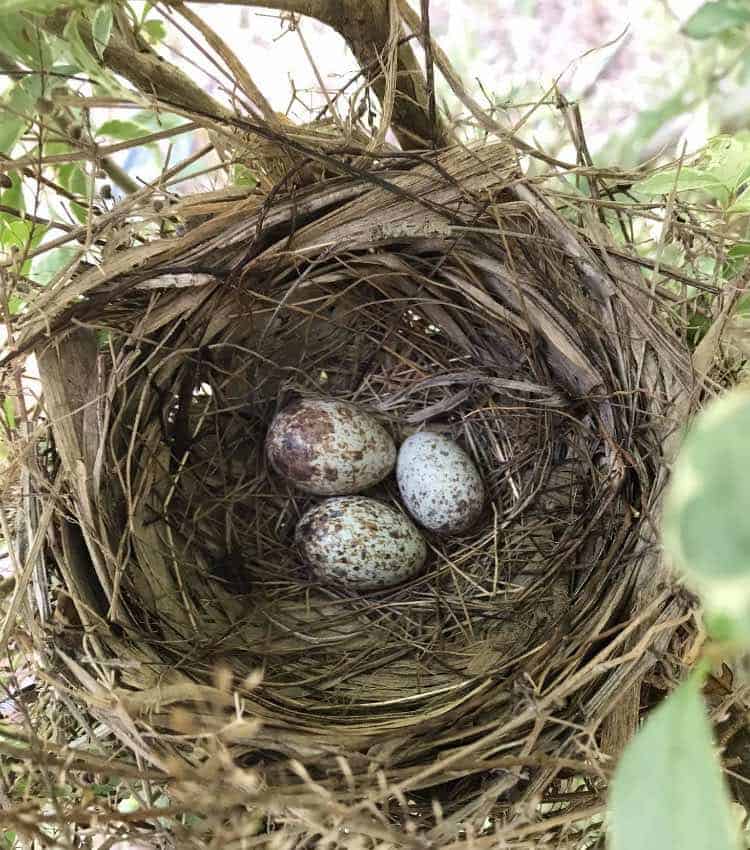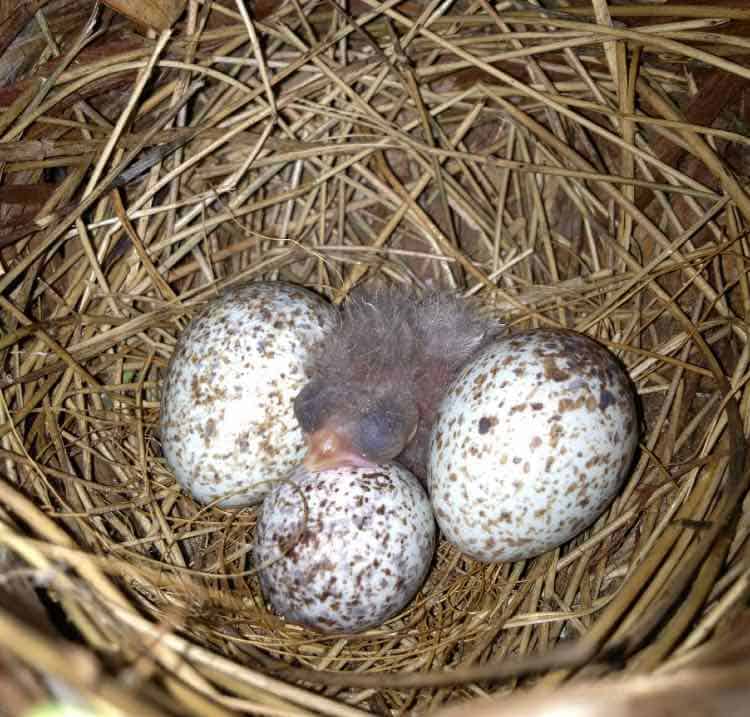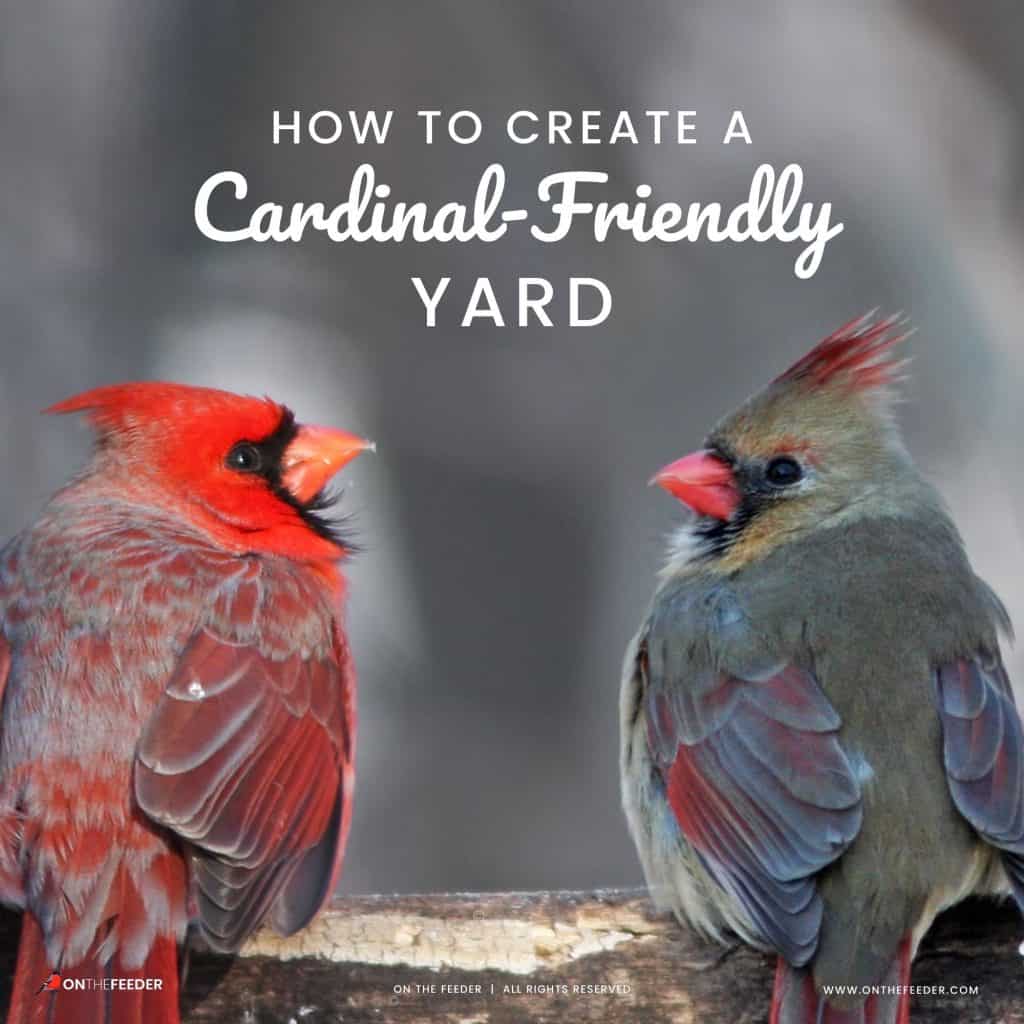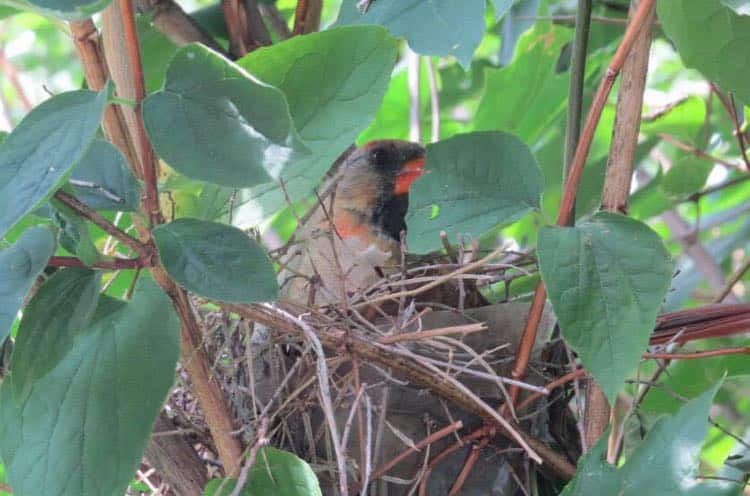Maybe you discovered a nest in your shrub and wonder if it’s a cardinal’s nest – but what does a cardinal nest look like? How does the cardinal make their nest and where do they nest? What about nesting boxes? Do they even use them? I have the answers to these questions and more on the topic of cardinal nests & nesting habits.
With more than 25 years of experience hosting backyard birds and having numerous cardinal pairs raise their young in my yard, I’m well-versed in cardinal nests and their nesting behavior. Of course, I don’t know everything so rely on my trusty advisor, Gary Ritchison, biologist and author of Wild Bird Guides: Northern Cardinal, to fill in the gaps.
In this article, I’ll walk through the chronological nesting habits of a cardinal pair starting with when nesting begins, who builds the nest, what materials the nest is made from, what the nest ultimately looks like when complete, and lots of other interesting tidbits about cardinal nests and their nesting habits.
To be clear, this article is about the northern cardinal. In case you weren’t aware, their name was changed from cardinal to northern cardinal back in the 1980s. On occasion I may reference cardinal or northern cardinal, please know they are referring to the same bird.
The Northern Cardinal Nesting Season
Cardinals begin to lay their eggs as early as March and have their last brood as late as September each year.
Cardinals have between 2 and 4 broods each season – broods are a fancy term for a set of eggs/babies. “Clutch” is another common term used to describe the number of eggs per egg-laying attempt.
The table below details how many broods the cardinals have each breeding season, the number of eggs per brood, the description of the eggs, the incubation period, and more.
Cardinal Nesting Overview
| Number of Broods | 2-4 per season |
| Nesting Season | March-August |
| Clutch Size (Number of Eggs) | 1-5 eggs per brood |
| Egg Description | About 1″ long and .75″ wide Either light gray, light green, or ivory with gray or brown specs |
| Incubation Period | 12-13 days |
| Appearance Upon Hatching | Naked and pink with grayish scaling, sparse bits of gray down, eyes closed |
| Fledging | Leaves the nest after 7-13 days. The dad cardinal typically cares for the fledglings but the mom will also help. |
Check out my in-depth article All About Cardinal Babies to discover what cardinal eggs look like, how long it takes cardinal eggs to hatch, what baby cardinals look like, when cardinal babies turn red when cardinal babies learn to fly, and a lot more information about baby cardinals.
The Nesting Steps
Since the northern cardinal has between 2 and 4 broods each season they’re repeating many nesting activities over and over. After the male and female have paired up, the nesting season goes something like this:
- The female chooses a nesting site;
- The female builds the nest;
- The pair copulates – a lot;
- The female cardinal lays eggs & incubates them;
- The eggs hatch;
- The pair feed the nestlings;
- The nestlings fledge;
- The male continues to feed and nurture the fledglings;
- The female scouts for the next nesting site;
- Rinse and repeat.
For those of us who love visuals, here are the northern cardinals’ nesting steps in an infographic:
Let’s explore the cardinal nest site scouting and nest building in more detail.
Step 1: Nesting Site Selection
The female cardinal selects the nesting site. She begins scouting for the perfect location after she’s chosen a mate or while she’s in the process of choosing one.
According to the Cornell Lab of Ornithology, the site location process can begin as soon as 1-2 weeks prior to nest building.
During the nest scouting phase, the female cardinal visits several nesting sites within the territory secured by her mate (or prospective mate) and assesses each site for potential. Since the northern cardinal’s primary goal in life is to reproduce, the ideal nesting site needs to offer protection from predators – the cardinal’s primary reproduction threat.
She usually scopes out sites along the edge of wooded areas, or in more open areas where thick shrubs, hedges, or similar vegetation exist (e.g. near a dwelling such as a house).
What kind of tree do cardinals nest in?
Northern cardinals build their nests in many different species of trees, shrubs, and vines. Since concealment is the primary goal of the nest, there are several different plants that meet that requirement including cedars, pines, maples, dogwoods, viburnum, and a whole lot more. In my yard, they’ve nested in a 5′ lilac bush, several feet high in a white pine tree, and inside my 4′ dogwood bushes.
Many backyard bird experts report hosting a cardinal’s nest in their hanging plant basket. As you can see, cardinals are not very choosy about what tree they use as long as the nest can be concealed.
If you happen to see her fluffing her feathers and turning her body you just may have witnessed her assessing a site for size and coverage for protection.
Do Cardinals return to the same nest again?
No. The female cardinal selects a new nesting site and builds a new nest for each brood. Previous nests are not used again.
Protection from predation is her main concern which can be very tricky since northern cardinal predators can come from above (osprey and hawks) and the ground (snakes, raccoons, and even other birds like Blue Jays and American Crows).
Whether she chooses a site high above or below ground level, predators are always going to be a threat. That said, she tends to choose the lowest site she can while still having some concealment for the cardinal nest.
For the initial broods, she typically selects relatively lower sites such as deep in the thick of a shrub. As the season goes on the nesting site location becomes higher such as in a cedar or pine tree. This is likely because vegetation growth is fuller and higher so she needs to choose a higher location to protect herself from the ground predators.
Step 2: The Nest is Built
Once the nesting site is selected she spends about 3-9 days building her 4″ x 3″ open-cup nest.
The northern cardinal nest is about 4″ x 3″, the shape of an open cup, and looks like a crudely constructed basket of twigs, stems, and fine bark strips, layered with leaves and lined with rootlets and grass stems.

The male cardinal provides most of the material to her but she is the primary builder.
When building the first nest of the season, the male cardinal will often stand guard while the female is busy working on the nest. If there are signs of danger he’ll alert her with a call.
The nest is comprised of three main components: the platform, the cup, and the lining.
Nest Platform
First, she builds a platform on a cluster of branches within the shrub or tree. The platform is made from stiff plant stems and twigs she finds and breaks into manageable pieces. She sits on the platform, grasps the materials, then bends and wraps them around her body to begin making the cup shape. She may even jump on it to force it into place.
Nest Outer Layer
Next, she constructs the cup using a layer of smooth dead leaves (especially grapevine leaves). Smooth materials are the goal here so when she’s building in an urban area she may even find paper or plastic to incorporate into the nest. She turns around in the nest and presses her body against it to continue making the shape.
Nest Inner Layer
The next layer of the nest consists of fine bark strips – especially grapevine if it’s available. Very small-diameter weed stems are also used in this layer.
Nest Lining
Finally, the lining is incorporated into the nest consisting of rootlets, grass stems, and pine needles. She continues using her body to press the materials into the nest until it becomes a single material. Northern cardinals will often use animal fur and other non-organic nesting materials to line their nest.
The result is an insulated, sturdy, protective, and soft nest to raise baby cardinals.
Early in the season, the nests tend to be heavier and thicker to offer better insulation for the young.
As the nesting period goes on and the temperatures rise, the nest construction thins out a bit to offer a cooler environment so as not to overheat the babies.
Steps 3 – 7: Copulation, Egg Laying & Hatching
At this point the nest is complete. While it was being built and shortly after, the pair “gets busy”, ensuring the female has a supply of sperm to fertilize her eggs.

She lays her eggs, incubates them, and the eggs hatch into fuzzy little hatchlings. Now, let’s get back to the subject of this article – nesting.
The Female Cardinal Chooses the NEXT Nesting Site
The latest brood has fledged and now it’s time for the female cardinal to choose the next nesting site. The nest from the newly fledged brood is abandoned. As mentioned earlier, cardinals do not reuse their nests.
She selects the next site similar to the previous sites except this time she looks for a higher location. It’s later in the season and plants have grown.
A site that was appropriate in early spring may have too much vegetation grown around it enabling predators to sneak up an attack. She needs a bit more openness to identify danger before it happens.
Would You Like More Cardinals to Visit Your Yard?

You can start by making sure your yard is inviting and friendly for cardinals. Download my FREE guide & checklist How to Create a Cardinal-Friendly Yard and you’ll have families of cardinals coming to visit year-round.
Nesting FAQ
Why Would Cardinals Abandon Their Nest?
There are three primary reasons northern cardinals would abandon their nest including:
1. A predator attacked the nest.
2. The female cardinal decided not to use the nest.
3. The brood has fledged the nest.
A Predator Attacked the Nest
If the cardinal nest has been overtaken by a predator, the male and female do not return to the nest.
Cardinals will even abandon the nest if the predator’s attack on the nest is imminent or in progress. Northern cardinals are wild animals and in nature, there are certain truths wild animals know that cause them to behave logically rather than emotionally.
In the case of cardinals, or most wild birds for that matter, they know they are no match for a snake or raccoon that wants their eggs for dinner so rather than also sacrifice themselves, they abandon the cardinal nest and move forward with finding the next nest site, building the nest, and producing the next brood.
One of the northern cardinal’s primary predators is house cats. Please keep the kitty inside.
Female Cardinal Decided Not to Use The Nest
Sometimes the female cardinal will build a nest and change her mind about using it to raise her young. It’s unclear why she may do this but some speculate she changed her mind about the safety of the location. In any case, she abandons the nest and it’s likely to never be used.
Cardinal Babies Have Fledged the Nest
Once the cardinal babies have fledged, the nest is no longer of use to the cardinal parents. Instead, she’ll find a new nesting site, build a new nest, lay eggs, and raise another brood. The previous nest is abandoned.
Do Cardinals Use Birdhouses or Nesting Boxes?
Cardinals will not use a birdhouse or nesting box because they are not cavity nesters. They construct a cup-shaped nest using plant materials inside a thick shrub for optimal protection from predators and inclement weather.
Next Steps
If you want to see these beautiful birds up close, the next step is to attract cardinals to your yard. !
- Put out a bird feeder that is suited for cardinals.
- Feed cardinals the food they prefer. Start with black oil sunflower seed and safflower seed.
- In winter, put out a heated birdbath.
Happy Birding!


